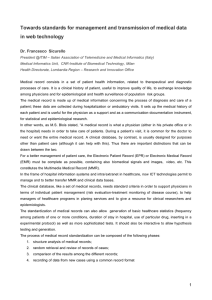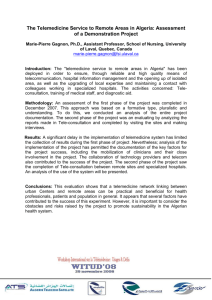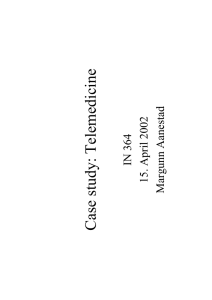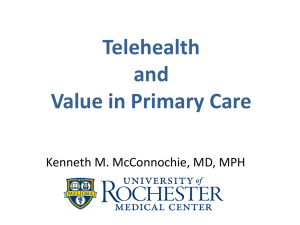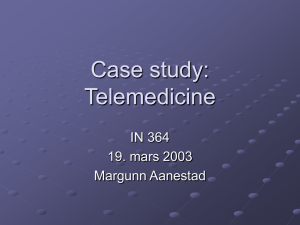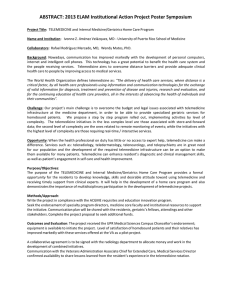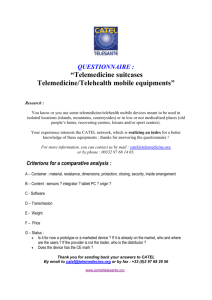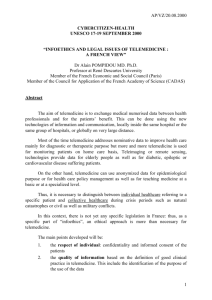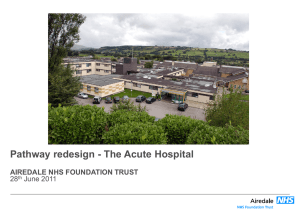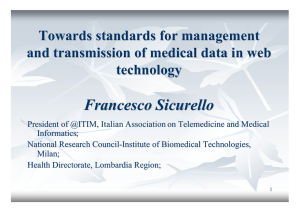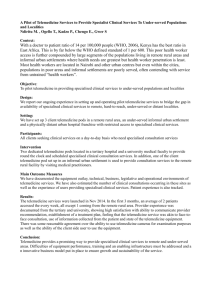Multimedia Medical Record
advertisement
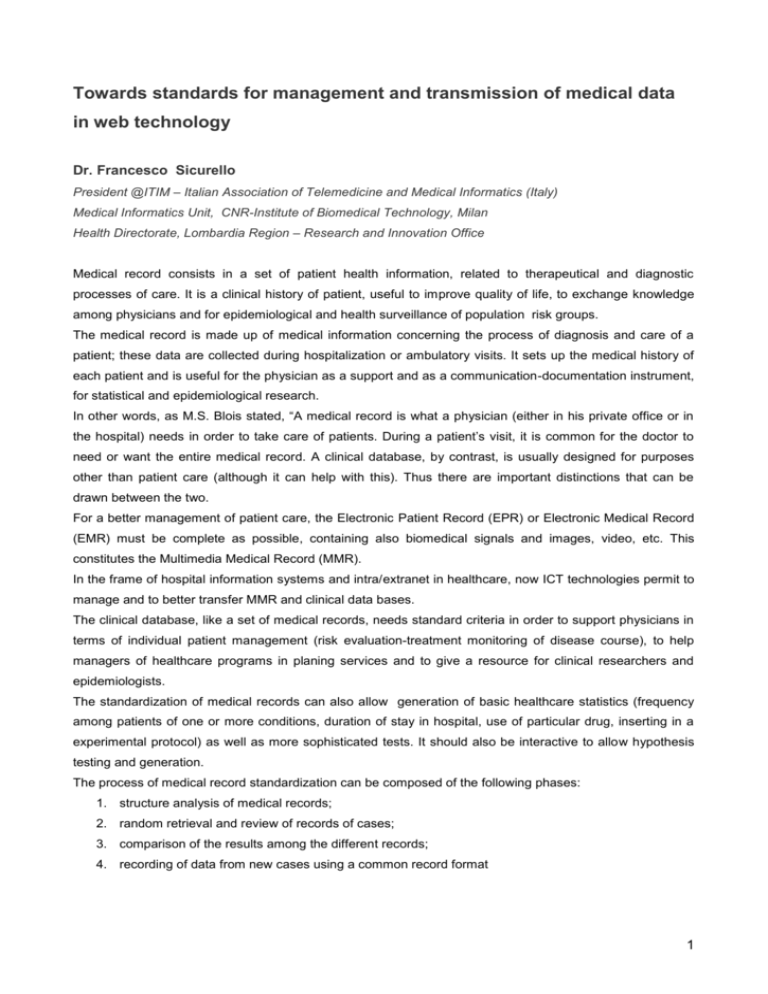
Towards standards for management and transmission of medical data in web technology Dr. Francesco Sicurello President @ITIM – Italian Association of Telemedicine and Medical Informatics (Italy) Medical Informatics Unit, CNR-Institute of Biomedical Technology, Milan Health Directorate, Lombardia Region – Research and Innovation Office Medical record consists in a set of patient health information, related to therapeutical and diagnostic processes of care. It is a clinical history of patient, useful to improve quality of life, to exchange knowledge among physicians and for epidemiological and health surveillance of population risk groups. The medical record is made up of medical information concerning the process of diagnosis and care of a patient; these data are collected during hospitalization or ambulatory visits. It sets up the medical history of each patient and is useful for the physician as a support and as a communication-documentation instrument, for statistical and epidemiological research. In other words, as M.S. Blois stated, “A medical record is what a physician (either in his private office or in the hospital) needs in order to take care of patients. During a patient’s visit, it is common for the doctor to need or want the entire medical record. A clinical database, by contrast, is usually designed for purposes other than patient care (although it can help with this). Thus there are important distinctions that can be drawn between the two. For a better management of patient care, the Electronic Patient Record (EPR) or Electronic Medical Record (EMR) must be complete as possible, containing also biomedical signals and images, video, etc. This constitutes the Multimedia Medical Record (MMR). In the frame of hospital information systems and intra/extranet in healthcare, now ICT technologies permit to manage and to better transfer MMR and clinical data bases. The clinical database, like a set of medical records, needs standard criteria in order to support physicians in terms of individual patient management (risk evaluation-treatment monitoring of disease course), to help managers of healthcare programs in planing services and to give a resource for clinical researchers and epidemiologists. The standardization of medical records can also allow generation of basic healthcare statistics (frequency among patients of one or more conditions, duration of stay in hospital, use of particular drug, inserting in a experimental protocol) as well as more sophisticated tests. It should also be interactive to allow hypothesis testing and generation. The process of medical record standardization can be composed of the following phases: 1. structure analysis of medical records; 2. random retrieval and review of records of cases; 3. comparison of the results among the different records; 4. recording of data from new cases using a common record format 1 Record Format Analysis Locating of main modules (personal data, follow up, laboratori, etc.) Chiose of common parameters in the different centres Selection of a retrospective sample of records Comparison and interpretation of results Definition of common set parameters to find Comparison of present results with the precedine one Variables Classification of Descriptive variables analysis of Estimate of parameters and prediction of illness evolution Data gathering of new cases Evaluation of answer, mistakes, missing cases,… Data analysis interpretation and results New definition and standardization of record Fig. 1 – Flow chart of a medical record standardization process The development of Multimedia Medical Record and heterogeneous data bases makes difficult the sharing of clinical information due to the difference of software platforms, data bases structures and connection between the location of the medical data. Moreover, there is the necessity of a common global communication standard. For example, DICOM (Digital Imaging and Communication in Medicine) is a standard model for images transfer (associated with clinical/diagnostic information), so that the images could be managed by a “multivendor” platforms system. Another standard for communication in the frame of Health Information Systems is HL7 (Health Level 7), This standard was created with the aim to exchange electronic data between health structures and different information systems. So that, the HL7 document is a basis of an EMR/EPR document-oriented. Diffusion of Internet and web technology, also in healthcare systems and intra/extranet architecture make necessary to rewrite medical records using new tools for database in web environment. HTML is not sufficient in solving the problems related to medical information transmission. HTML is based on data presentation (data form) and not on the data contents, in this way the doctor can consult a list of data but it is not possible to send them to another doctor or to make a “cut and paste” on his data base. 2 With the use of SGML (Standardized General Markup Language, standard ISO 8879:1986) and XML (eXtensible Markup Language) it is possible now to solve this problem, making a standardization of the information exchanged and not of the data format. Developing MMR using XML can favourite diffusion of telemedicine, using Internet services, with strong reduction of costs. Telemedicine uses ICT to deliver health care, often over great distances, with the possibility of cost saving particularly in remote and rural areas. Telemedicine delivers a more cost-effective solution for health care systems, providing better clinical outcomes as well as improving a patient’ quality of life (diseases management, manage ageing population, etc.). Telemedicine means, literally, 'medicine at a distance'. There are several different definitions, of telemedicine but by the WHO of Geneva in December 1997 has been adopted the following: “Telemedicine is the delivery of health-care services, where distance is a critical factor, by health-care professionals using information and communication technologies for the exchange of valid information far diagnosis, treatment and prevention of disease and injuries, and for the continuing education of health-care providers as well as research and evaluation, all in the interests of advancing the health of individuals and their communities.” By means telemedicine systems, patient care and treatment can be delivered transmitting data of the medical record and permitting so teleconsulting/telediagnosis between doctors and telemonitoring/teleassistance to a single patient. Some areas of telemedicine are: telecardiology, teleradiology, telepatology, etc. One of the most interesting medical area, in which the MMR can be used for telediagnosis/teleconsulting and in telemonitoring/telesurveillance of patient, is cardiology. In cardiology there is a large request of specialistic tests, so that the integration of data and signals (ECG, ECO, etc.) into medical record facilitates the care treatments and the possibility to ask for a diagnosis and/or for second opinion consulting in short time and with low costs. Fig. 2 – Telecardiological System. 3 A Tele-cardiological system is the set of: 1. peripheral equipment of survey of the data and clinical parameters; 2. telecommunication net that allows the connection of the equipments; 3. operating plan of receipt, treatment and report of the data; 4. operating protocol, which must be always followed by the doctors in service. Particular attention must be dedicated to communication of signals and to the interface with the electromedical instruments (Electrocardiograph, Echograph, etc). The peripheral equipment is substantially constituted by two parts: a telephone interface, through the existing telephone network and an under-unity which notifies the specific medical parameters and move them for the transmission to the telephone interface. (One under-unity more common today it is the digital electrocardiograph). A teleradiological platform for Teconsulting/Telediagnosis can be composed by: personal computer of recent generation; connection in geographic net between the headmasters, realized through the introduction of suitable net apparatuses; software of elaboration and acquisition of the images with registration functionality according to the DICOM3 standard; monitor for the reporting with 2 Mpixel resolution. Telepathology is a practical activity of the pathology to distance, able to have the images of the slides seen on a screen instead than through the microscope. The transmitted images can be used for primary diagnoses, second opinion, check of quality control, ability tests and widening at distance. Telepathology platform is constituted by base components: microscope, tele-camera, PC, communication network, architecture client/server, relational DBMS, SW Firewall, SW of compression of the images (i.e. Jpeg). An example of telemedicine system (in particular related to telecardiology and telepathology) is between Italian hospital in Cairo and Civic Hospital in Palermo (fig. 3). This application involves the cardiosurgery department and the pathology services of two Hospitals. The aim of the project is to permit teleconsulting/telediagnosis, 2 nd opinion between clinicians and to create a medical network that will improve the dissemination and exchange of medical information and knowledge between doctors, researchers and health operators of the two hospitals. 4 Fig.3. Telemedicine system. 5
